Calvin Yeung
SoccerNet 2025 Challenges Results
Aug 26, 2025Abstract:The SoccerNet 2025 Challenges mark the fifth annual edition of the SoccerNet open benchmarking effort, dedicated to advancing computer vision research in football video understanding. This year's challenges span four vision-based tasks: (1) Team Ball Action Spotting, focused on detecting ball-related actions in football broadcasts and assigning actions to teams; (2) Monocular Depth Estimation, targeting the recovery of scene geometry from single-camera broadcast clips through relative depth estimation for each pixel; (3) Multi-View Foul Recognition, requiring the analysis of multiple synchronized camera views to classify fouls and their severity; and (4) Game State Reconstruction, aimed at localizing and identifying all players from a broadcast video to reconstruct the game state on a 2D top-view of the field. Across all tasks, participants were provided with large-scale annotated datasets, unified evaluation protocols, and strong baselines as starting points. This report presents the results of each challenge, highlights the top-performing solutions, and provides insights into the progress made by the community. The SoccerNet Challenges continue to serve as a driving force for reproducible, open research at the intersection of computer vision, artificial intelligence, and sports. Detailed information about the tasks, challenges, and leaderboards can be found at https://www.soccer-net.org, with baselines and development kits available at https://github.com/SoccerNet.
KASportsFormer: Kinematic Anatomy Enhanced Transformer for 3D Human Pose Estimation on Short Sports Scene Video
Jul 28, 2025Abstract:Recent transformer based approaches have demonstrated impressive performance in solving real-world 3D human pose estimation problems. Albeit these approaches achieve fruitful results on benchmark datasets, they tend to fall short of sports scenarios where human movements are more complicated than daily life actions, as being hindered by motion blur, occlusions, and domain shifts. Moreover, due to the fact that critical motions in a sports game often finish in moments of time (e.g., shooting), the ability to focus on momentary actions is becoming a crucial factor in sports analysis, where current methods appear to struggle with instantaneous scenarios. To overcome these limitations, we introduce KASportsFormer, a novel transformer based 3D pose estimation framework for sports that incorporates a kinematic anatomy-informed feature representation and integration module. In which the inherent kinematic motion information is extracted with the Bone Extractor (BoneExt) and Limb Fuser (LimbFus) modules and encoded in a multimodal manner. This improved the capability of comprehending sports poses in short videos. We evaluate our method through two representative sports scene datasets: SportsPose and WorldPose. Experimental results show that our proposed method achieves state-of-the-art results with MPJPE errors of 58.0mm and 34.3mm, respectively. Our code and models are available at: https://github.com/jw0r1n/KASportsFormer
AthletePose3D: A Benchmark Dataset for 3D Human Pose Estimation and Kinematic Validation in Athletic Movements
Mar 11, 2025Abstract:Human pose estimation is a critical task in computer vision and sports biomechanics, with applications spanning sports science, rehabilitation, and biomechanical research. While significant progress has been made in monocular 3D pose estimation, current datasets often fail to capture the complex, high-acceleration movements typical of competitive sports. In this work, we introduce AthletePose3D, a novel dataset designed to address this gap. AthletePose3D includes 12 types of sports motions across various disciplines, with approximately 1.3 million frames and 165 thousand individual postures, specifically capturing high-speed, high-acceleration athletic movements. We evaluate state-of-the-art (SOTA) monocular 2D and 3D pose estimation models on the dataset, revealing that models trained on conventional datasets perform poorly on athletic motions. However, fine-tuning these models on AthletePose3D notably reduces the SOTA model mean per joint position error (MPJPE) from 214mm to 65mm-a reduction of over 69%. We also validate the kinematic accuracy of monocular pose estimations through waveform analysis, highlighting strong correlations in joint angle estimations but limitations in velocity estimation. Our work provides a comprehensive evaluation of monocular pose estimation models in the context of sports, contributing valuable insights for advancing monocular pose estimation techniques in high-performance sports environments. The dataset, code, and model checkpoints are available at: https://github.com/calvinyeungck/AthletePose3D
OpenSTARLab: Open Approach for Spatio-Temporal Agent Data Analysis in Soccer
Feb 06, 2025



Abstract:Sports analytics has become both more professional and sophisticated, driven by the growing availability of detailed performance data. This progress enables applications such as match outcome prediction, player scouting, and tactical analysis. In soccer, the effective utilization of event and tracking data is fundamental for capturing and analyzing the dynamics of the game. However, there are two primary challenges: the limited availability of event data, primarily restricted to top-tier teams and leagues, and the scarcity and high cost of tracking data, which complicates its integration with event data for comprehensive analysis. Here we propose OpenSTARLab, an open-source framework designed to democratize spatio-temporal agent data analysis in sports by addressing these key challenges. OpenSTARLab includes the Pre-processing Package that standardizes event and tracking data through Unified and Integrated Event Data and State-Action-Reward formats, the Event Modeling Package that implements deep learning-based event prediction, alongside the RLearn Package for reinforcement learning tasks. These technical components facilitate the handling of diverse data sources and support advanced analytical tasks, thereby enhancing the overall functionality and usability of the framework. To assess OpenSTARLab's effectiveness, we conducted several experimental evaluations. These demonstrate the superior performance of the specific event prediction model in terms of action and time prediction accuracies and maintained its robust event simulation performance. Furthermore, reinforcement learning experiments reveal a trade-off between action accuracy and temporal difference loss and show comprehensive visualization. Overall, OpenSTARLab serves as a robust platform for researchers and practitioners, enhancing innovation and collaboration in the field of soccer data analytics.
A Zero-Shot LLM Framework for Automatic Assignment Grading in Higher Education
Jan 24, 2025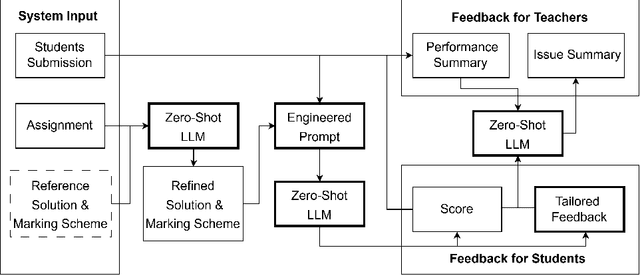

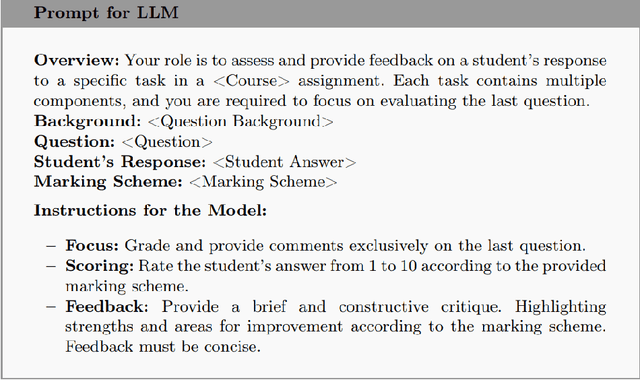

Abstract:Automated grading has become an essential tool in education technology due to its ability to efficiently assess large volumes of student work, provide consistent and unbiased evaluations, and deliver immediate feedback to enhance learning. However, current systems face significant limitations, including the need for large datasets in few-shot learning methods, a lack of personalized and actionable feedback, and an overemphasis on benchmark performance rather than student experience. To address these challenges, we propose a Zero-Shot Large Language Model (LLM)-Based Automated Assignment Grading (AAG) system. This framework leverages prompt engineering to evaluate both computational and explanatory student responses without requiring additional training or fine-tuning. The AAG system delivers tailored feedback that highlights individual strengths and areas for improvement, thereby enhancing student learning outcomes. Our study demonstrates the system's effectiveness through comprehensive evaluations, including survey responses from higher education students that indicate significant improvements in motivation, understanding, and preparedness compared to traditional grading methods. The results validate the AAG system's potential to transform educational assessment by prioritizing learning experiences and providing scalable, high-quality feedback.
SoccerSynth-Detection: A Synthetic Dataset for Soccer Player Detection
Jan 16, 2025



Abstract:In soccer video analysis, player detection is essential for identifying key events and reconstructing tactical positions. The presence of numerous players and frequent occlusions, combined with copyright restrictions, severely restricts the availability of datasets, leaving limited options such as SoccerNet-Tracking and SportsMOT. These datasets suffer from a lack of diversity, which hinders algorithms from adapting effectively to varied soccer video contexts. To address these challenges, we developed SoccerSynth-Detection, the first synthetic dataset designed for the detection of synthetic soccer players. It includes a broad range of random lighting and textures, as well as simulated camera motion blur. We validated its efficacy using the object detection model (Yolov8n) against real-world datasets (SoccerNet-Tracking and SportsMoT). In transfer tests, it matched the performance of real datasets and significantly outperformed them in images with motion blur; in pre-training tests, it demonstrated its efficacy as a pre-training dataset, significantly enhancing the algorithm's overall performance. Our work demonstrates the potential of synthetic datasets to replace real datasets for algorithm training in the field of soccer video analysis.
Enhanced Multi-Object Tracking Using Pose-based Virtual Markers in 3x3 Basketball
Dec 09, 2024



Abstract:Multi-object tracking (MOT) is crucial for various multi-agent analyses such as evaluating team sports tactics and player movements and performance. While pedestrian tracking has advanced with Tracking-by-Detection MOT, team sports like basketball pose unique challenges. These challenges include players' unpredictable movements, frequent close interactions, and visual similarities that complicate pose labeling and lead to significant occlusions, frequent ID switches, and high manual annotation costs. To address these challenges, we propose a novel pose-based virtual marker (VM) MOT method for team sports, named Sports-vmTracking. This method builds on the vmTracking approach developed for multi-animal tracking with active learning. First, we constructed a 3x3 basketball pose dataset for VMs and applied active learning to enhance model performance in generating VMs. Then, we overlaid the VMs on video to identify players, extract their poses with unique IDs, and convert these into bounding boxes for comparison with automated MOT methods. Using our 3x3 basketball dataset, we demonstrated that our VM configuration has been highly effective, and reduced the need for manual corrections and labeling during pose model training while maintaining high accuracy. Our approach achieved an average HOTA score of 72.3%, over 10 points higher than other state-of-the-art methods without VM, and resulted in 0 ID switches. Beyond improving performance in handling occlusions and minimizing ID switches, our framework could substantially increase the time and cost efficiency compared to traditional manual annotation.
SoccerNet 2024 Challenges Results
Sep 16, 2024
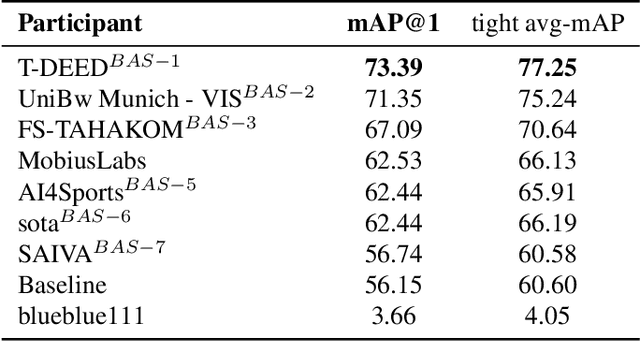
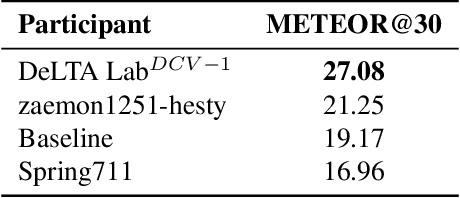
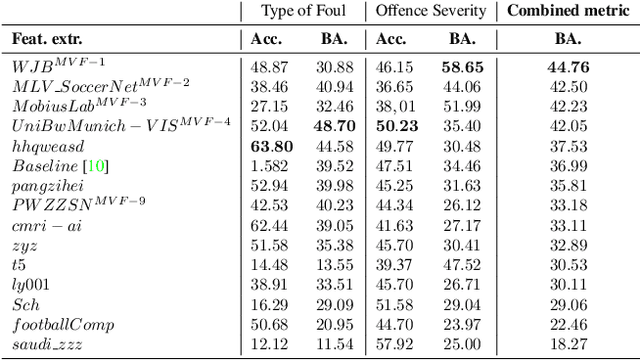
Abstract:The SoccerNet 2024 challenges represent the fourth annual video understanding challenges organized by the SoccerNet team. These challenges aim to advance research across multiple themes in football, including broadcast video understanding, field understanding, and player understanding. This year, the challenges encompass four vision-based tasks. (1) Ball Action Spotting, focusing on precisely localizing when and which soccer actions related to the ball occur, (2) Dense Video Captioning, focusing on describing the broadcast with natural language and anchored timestamps, (3) Multi-View Foul Recognition, a novel task focusing on analyzing multiple viewpoints of a potential foul incident to classify whether a foul occurred and assess its severity, (4) Game State Reconstruction, another novel task focusing on reconstructing the game state from broadcast videos onto a 2D top-view map of the field. Detailed information about the tasks, challenges, and leaderboards can be found at https://www.soccer-net.org, with baselines and development kits available at https://github.com/SoccerNet.
Basketball-SORT: An Association Method for Complex Multi-object Occlusion Problems in Basketball Multi-object Tracking
Jun 28, 2024Abstract:Recent deep learning-based object detection approaches have led to significant progress in multi-object tracking (MOT) algorithms. The current MOT methods mainly focus on pedestrian or vehicle scenes, but basketball sports scenes are usually accompanied by three or more object occlusion problems with similar appearances and high-intensity complex motions, which we call complex multi-object occlusion (CMOO). Here, we propose an online and robust MOT approach, named Basketball-SORT, which focuses on the CMOO problems in basketball videos. To overcome the CMOO problem, instead of using the intersection-over-union-based (IoU-based) approach, we use the trajectories of neighboring frames based on the projected positions of the players. Our method designs the basketball game restriction (BGR) and reacquiring Long-Lost IDs (RLLI) based on the characteristics of basketball scenes, and we also solve the occlusion problem based on the player trajectories and appearance features. Experimental results show that our method achieves a Higher Order Tracking Accuracy (HOTA) score of 63.48$\%$ on the basketball fixed video dataset and outperforms other recent popular approaches. Overall, our approach solved the CMOO problem more effectively than recent MOT algorithms.
AutoSoccerPose: Automated 3D posture Analysis of Soccer Shot Movements
May 20, 2024Abstract:Image understanding is a foundational task in computer vision, with recent applications emerging in soccer posture analysis. However, existing publicly available datasets lack comprehensive information, notably in the form of posture sequences and 2D pose annotations. Moreover, current analysis models often rely on interpretable linear models (e.g., PCA and regression), limiting their capacity to capture non-linear spatiotemporal relationships in complex and diverse scenarios. To address these gaps, we introduce the 3D Shot Posture (3DSP) dataset in soccer broadcast videos, which represents the most extensive sports image dataset with 2D pose annotations to our knowledge. Additionally, we present the 3DSP-GRAE (Graph Recurrent AutoEncoder) model, a non-linear approach for embedding pose sequences. Furthermore, we propose AutoSoccerPose, a pipeline aimed at semi-automating 2D and 3D pose estimation and posture analysis. While achieving full automation proved challenging, we provide a foundational baseline, extending its utility beyond the scope of annotated data. We validate AutoSoccerPose on SoccerNet and 3DSP datasets, and present posture analysis results based on 3DSP. The dataset, code, and models are available at: https://github.com/calvinyeungck/3D-Shot-Posture-Dataset.
 Add to Chrome
Add to Chrome Add to Firefox
Add to Firefox Add to Edge
Add to Edge